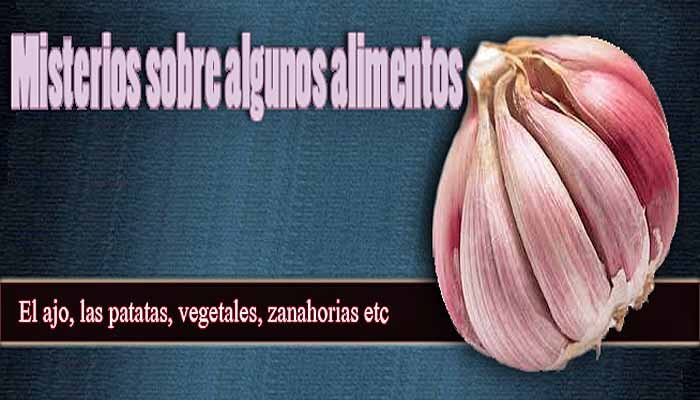Mysteries of some foods

If you’re serious about your health, then you probably already know which foods to eat and which to avoid (any processed food or high glycemic index ). Even though you already have this knowledge, you could still be missing some hidden benefits in the foods you eat.
To unlock the full nutritional potential of your meals, remember that the vegetables, fruits, and other whole foods we eat are living organisms, too. As such, they have their own self defense biomechanisms to protect them from predators. The byproduct of these biological mechanisms such as trace elements, carotenoids, polyphenols, flavonoids and phytochemicals can also protect us from health problems.

Garlic
Garlic offers enormous health benefits , but many people shoot themselves in the foot for the way they cook with it. People tend to mince garlic and immediately throw it into a heat source. There’s no question that the added garlic adds an unparalleled depth of flavor, sadly, the rush to pan kills the primary health benefits of garlic.
Garlic contains a protein element called alliin and a heat-sensitive enzyme called alliinase . When you cut a thin membrane from garlic, alliin and alliinase are synthesized into an antimicrobial compound called allicin, which may have the ability to fight cancer and heart-related diseases.
Garlic sounds amazing so far, but here’s the catch: A group of food chemists pointed out that applying heat immediately after cutting garlic destroys alliinase – that very enzyme needed to form the most valuable component of garlic. . By this time, most of its healing properties have been completely lost and are on fire.
The good news is that you can still cook garlic and reap its properties (and flavor), simply by letting the chopped garlic rest for a bit. That’s it. Once you mince the garlic, keep it away from heat and let it rest for 8-10 minutes before cooking. This short wait time allows the allicin process to complete.
Potatoes
The fast-digesting starches found in potatoes actually raise blood sugar almost as high and as fast as eating white sugar with a spoon. This is especially true if you buy the standard supermarkets like the white meat Russet or ready-to-fry potatoes.
Although our bodies are designed to handle the rapid rise in blood glucose from high glycemic foods with a hormone called insulin, consuming large amounts of sugary foods on a regular basis can lead to a condition called resistance to insulin.
At that point, blood glucose can no longer be adequately controlled without medication. The development of this process usually leads to type 2 diabetes.
The solution is to cook the potato and then chill it in the fridge for approximately 24 hours. The colder temperature lowers the glycemic index of starches, lowering it by 25 percent, resulting in a rise in blood glucose. The pancreas will thank you, as it is responsible for the release of insulin. Excessive demands on the pancreas from repeated glucose spikes damage the organ over time.
From that moment on, the cold will lower the glycemic index of the potatoes for you to enjoy, worry-free. You can also slow down the digestion of starch by adding fat to potatoes (olive oil for example)
Carrots
For mysterious reasons, carrots cut after they have been cooked provide more nutritional value than cut them before they have been cooked.
For some, this may be a disappointing realization, as raw carrots are some of the most portable and convenient veggies for snacking.
Surprisingly, cooking the whole carrot and then slicing it will increase its nutritional value and improve the taste. Carrots cooked without chopping tend to be sweeter, but more importantly, they retain about more than 25 percent of a compound called falcarinol, which protects carrots from diseases caused by fungi in nature. Falcarinol has cancer-fighting properties.
Carrots also contain beta-carotene – a healthy compound that makes them that orange color. Do not forget that in order to absorb this nutrient you have to combine them with some fats.
Walnuts
Nuts of all kinds are packed with protein, omega-6 fatty acids, trace minerals, and make a great and convenient snack. Unfortunately, nuts in their unaltered form also contain high amounts of “anti-nutrients,” more specifically phytic acid, lectins, enzyme inhibitors, and in some cases, even mold.
Phytic acid and these anti-nutrients are indigestible in humans and wreak havoc on the body as they greedily cling to minerals like calcium, iron, zinc, and others. Consuming a large amount of these nuts without first putting it through a process called sprouting could lead to severe mineral deficiencies and loss of bone density.
Sprouts consist of soaking the walnuts in water (salted water, or sometimes an acidic solution also works) for a predetermined length of time. Exposure to moisture mimics something that occurs in nature when walnuts create enzymes to break down anti-nutrients. What this ultimately means is that properly sprouted nuts have increased their nutritional value and will be easier to digest.
The dive time depends on the type and quantity, and can vary from a few hours to a full day.

Vegetables
Boiled vegetables are still a staple among fat-loss-wanting people and bodybuilders’ diets. Chicken and boiled vegetables, anyone? Certainly, it is quick, comfortable and easy to do. But have you ever wondered why the cooking water turns green after broccoli floats around for a while? Perhaps even sadder is that the water pours quickly without even a shrug of the shoulders, leaving nothing but a less nutritious bundle of green matter fibers that can hardly be called broccoli.
It turns out that boiled veggies are perhaps the fastest way to lose nutrients. In addition to making the step towards an absolutely tasteless meal, boiled vegetables filter out all the valuable nutrients soluble in the cooking water. At that point, you should only drink the water in order to save the loose nutrients.
If you want to take advantage of eating veggies in the first place, consider sautéing the veggies with a little butter or oil, or even steaming it.
Leave a Reply